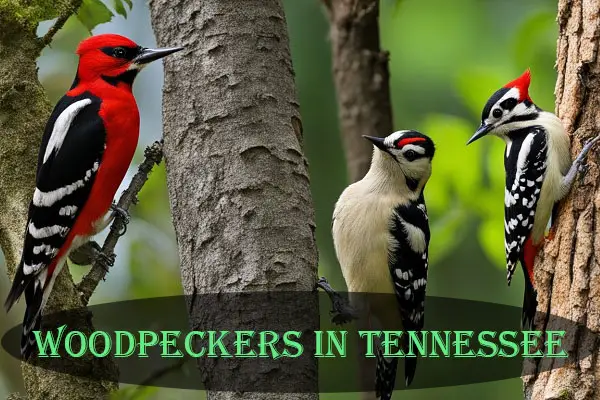6 Type Woodpeckers In Tennessee (With Picture)
Tennessee is a haven for woodpeckers, with over 430 bird species. It’s a great place for these interesting birds. But do you know the different types of woodpeckers here? Let’s explore the unique features, behaviors, and habitats of the 7 most common woodpeckers in Tennessee.
Woodpeckers In Tennessee
Tennessee is a top spot for birdwatchers and nature lovers to see many woodpecker types. You can find everything from the big Pileated Woodpecker to the small Downy Woodpecker. These birds live in forests, parks, and even in cities. Places like the Great Smoky Mountains National Park and Tennessee National Wildlife Refuge are great for seeing them in the wild.
In Tennessee, you can find seven kinds of woodpeckers. They include the Downy, Hairy, Pileated, Red-bellied, Red-headed, Northern Flicker, and Yellow-bellied Sapsucker. These birds help the forest by making homes for other animals and breaking down dead trees.
Sometimes, woodpeckers can be a problem for people in Tennessee, especially in Nashville. They might make holes in buildings to make nests or roosts. But, there are ways to stop this, like making a spot less appealing, leaving dead trees up, putting up special boxes for them, or using methods to keep them away.
| Woodpecker Species | Wingspan | Average Weight | Nest Cavity | Incubation Period | Time in Nest |
|---|---|---|---|---|---|
| Pileated Woodpecker | 29 inches | 10 ounces | 3-5 eggs | 15-18 days | 24-28 days |
| Downy Woodpecker | – | – | – | – | – |
| Hairy Woodpecker | – | – | – | – | – |
| Red-bellied Woodpecker | – | – | – | – | – |
| Red-headed Woodpecker | – | – | – | – | – |
| Northern Flicker | – | – | – | – | – |
| Yellow-bellied Sapsucker | – | – | – | – | – |
The Yellow-bellied Sapsucker is the only woodpecker that moves a lot in Tennessee. They do this because their food trees go dormant and there’s no sap for them. Woodpeckers might also hit on houses for food, to mark their territory, or to make homes.
For woodpecker problems, only wildlife rescue experts in Tennessee can help. They use different ways to keep woodpeckers away from buildings, like special devices, looks, and sounds.
1. Pileated Woodpecker
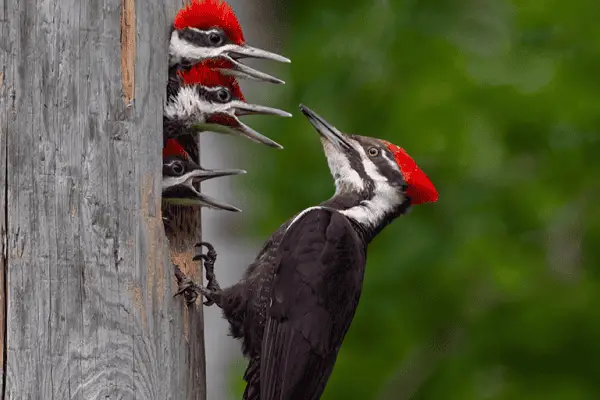
The Pileated Woodpecker is a giant among Tennessee’s woodpeckers. It stands out with its black body, white stripes, and red crest. These birds are famous for their strong pecking skills. They make big holes in trees to find carpenter ants and other insects. Their loud calls and unique flight make them easy to spot in Tennessee’s forests.
Identification and Behavior
Pileated Woodpeckers are the biggest in North America, reaching 16-19 inches long. They look like a mix of a crow and a woodpecker, with a black body and white belly. Their strong beaks help them dig big holes in trees for carpenter ants. You can also hear their loud calls and see their unique flight as they move through the woods.
Habitat and Conservation Status
These woodpeckers love mature forests and suburban woods. They need big, old trees for their nests. Luckily, their numbers are growing, and they’re not considered endangered. But, losing old trees could still harm their homes.
| Pileated Woodpecker Facts | Details |
|---|---|
| Size | Approximately 16-19 inches in length, nearly the size of a crow |
| Appearance | Massive black body, white stripes on the face and neck, and prominent red crest |
| Foraging | Known for their powerful pecking, creating large, rectangular holes in search of carpenter ants and other wood-boring insects |
| Habitat | Thrive in mature, deciduous and mixed forests, as well as in wooded suburban areas |
| Conservation Status | Currently listed as Least Concern by the IUCN, with a steadily increasing population |
2. Hairy Woodpecker
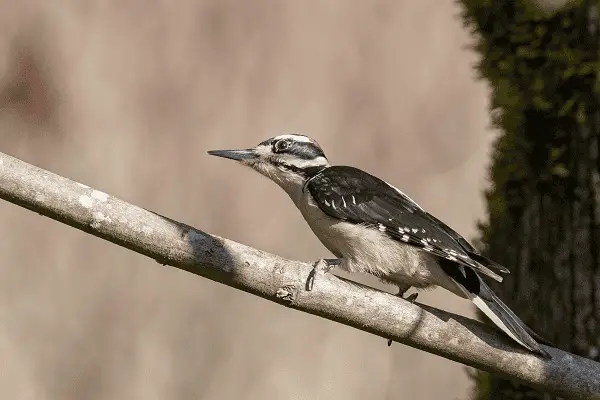
The Hairy Woodpecker looks a lot like the smaller Downy Woodpecker but has a bigger beak and a larger white patch on its back. They live in areas with lots of trees, like parks and places with big trees near homes. They eat insects, larvae, and other small bugs, helping to keep wood-boring pests under control.
Even though they’re not as common as the Downy, the Hairy Woodpecker is still found all over Tennessee. They stand out with their black and white feathers and loud calls. Their size and strong beak let them eat bigger insects and reach deep into tree bark.
| Characteristic | Hairy Woodpecker | Downy Woodpecker |
|---|---|---|
| Size | Medium-sized | Smaller |
| Beak | Noticeably larger | Smaller |
| White Patch on Back | More prominent | Less prominent |
| Habitat | Mature, well-wooded areas, including parks and suburban environments with large trees | Variety of wooded habitats, including urban and suburban areas |
| Diet | Insects, larvae, and other invertebrates | Insects, larvae, and other invertebrates |
| Abundance in Tennessee | Widespread and abundant | More common than Hairy Woodpecker |
The Hairy Woodpecker is a key bird in Tennessee’s bird world. It helps keep forests healthy by eating insects. Even though they might not be as easy to see as some other birds, they are still a joy to watch in nature.
3. Northern Flicker

The Northern Flicker is a large and unique woodpecker found in Tennessee. It comes in two subspecies. The red-shafted form has a red stripe and red feathers on its tail and wings. The yellow-shafted form has a black stripe and yellow feathers on its tail and wings. Both have grey-brown tops, buff bottoms, and black spots.
Plumage and Subspecies Variations
Northern Flickers have different feathers, with the red-shafted and yellow-shafted forms mixing from Alaska to Texas. They used to be seen as different species but are now one adaptable species.
Habitat Preferences and Behavior
These woodpeckers like open areas with trees, like forest edges, parks, and suburbs. They eat ants and insects on the ground. They live in dead trees and make loud calls. Their numbers have gone down, but they’re still common in Tennessee, helping control insect pests.
| Characteristic | Red-shafted Northern Flicker | Yellow-shafted Northern Flicker |
|---|---|---|
| Moustachial Stripe | Red | Black |
| Tail and Flight Feathers | Red | Yellow |
| Upperparts | Grey-brown | Grey-brown |
| Underparts | Buff | Buff |
| Spotting | Black | Black |
4. Downy Woodpecker

In Tennessee, the Downy Woodpecker is the smallest woodpecker species. It’s small but amazing, showing off its acrobatic skills. It moves through tree trunks and branches to find food.
Identification and Feeding Habits
The Downy Woodpecker is known for its black and white look and a short, stubby beak. This beak is great for finding insects and larvae in tree bark. They also visit fence posts and telephone poles for food.
These birds like to forage with other small birds like chickadees and titmice. They work together to find food.
Adaptability to Different Habitats
The Downy Woodpecker can live in many places in Tennessee. They like forests and even suburban yards with trees. They do well in young forests and cities with trees too.
Downy Woodpeckers are easy to see in Tennessee. They bring life and energy to the places they live. Birdwatchers and nature lovers find them very interesting.
5. Red-headed Woodpecker
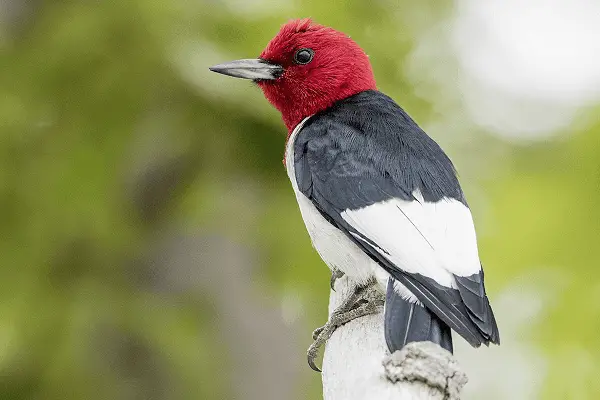
The Red-headed Woodpecker is a standout in Tennessee, known for its bright red head and black and white wings. It also has a white belly. This bird is famous for catching insects in mid-air and storing acorns for later. Its bold look and hunting style make it a hit with bird lovers.
Distinctive Appearance and Behavior
This bird is smaller than a crow and has a scarlet head and a spiky bill. It’s known for catching insects in mid-flight and storing acorns in tree crevices. The Red-headed Woodpecker’s bold look and hunting style are why it’s loved by Tennessee’s birdwatchers.
Habitat Preferences and Conservation Status
Red-headed Woodpeckers live in semi-open areas with big trees, often in parks and near wetlands. But, their numbers have gone down due to habitat loss. Now, they’re considered a conservation concern, showing how important it is to protect their homes.
| Species | Size Comparison | Habitat | Conservation Status |
|---|---|---|---|
| Red-headed Woodpecker | Smaller than a crow | Semi-open habitats with mature oak trees, snags, and other large trees | Listed as a species of conservation concern in some parts of its range |
| Red-Bellied Woodpecker | Common in the eastern United States, males have a red nape and a black-and-white striped back | Diverse habitats, including forests, woodlands, and suburban areas | Stable population, not a conservation concern |
| Downy Woodpecker | The smallest and most common woodpecker in the U.S., slightly smaller than a robin with a pale belly and a short bill | Adaptable to various habitats, including urban and suburban areas | Widespread and common, not a conservation concern |
6. Yellow-bellied Sapsucker
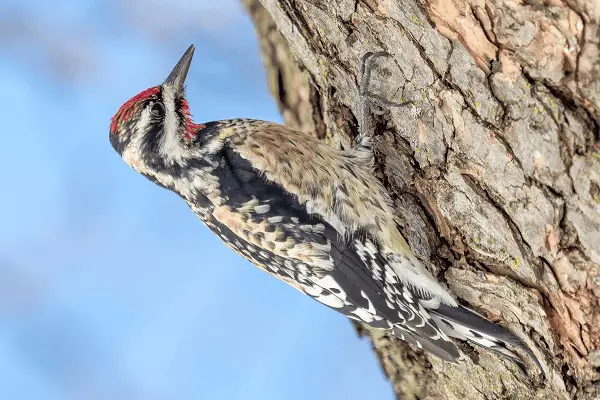
The Yellow-bellied Sapsucker is a unique bird in Tennessee’s woodpecker family. It stands out with its black-and-white face, red crown, and pale yellow belly. Its main food is tree sap, which makes it special.
Identification and Unique Feeding Habits
This bird is different from others because it eats sap. It drills holes in trees to get to the sap. The sap and insects around it are its main food.
This bird moves around seasonally. It goes to northern forests in summer and comes to Tennessee in winter. You can see it on trees like birches and sugar maples, eating from over 1,000 different species.
| Breeding Range | Winter Range |
|---|---|
| Eastern North America and Canada, mainly in boreal forest | The northern Caribbean, including the Bahamas, Cuba, and other islands, as well as Central America |
The Yellow-bellied Sapsucker is the only migratory woodpecker in eastern North America. Females often go farther south in winter than males. These birds live in places with trees, like forests, gardens, and coastal areas.
After two weeks, the young hatch and eat insects mixed with sap. Males do most of the nest work and help with eggs and feeding. If a parent dies, the young are more likely to survive if the father takes care of them.
Where to See Woodpeckers in Tennessee
Tennessee is a great place to see many woodpecker species. Top spots include the Great Smoky Mountains National Park, Tennessee National Wildlife Refuge, and Frozen Head State Park. You can also visit Brainerd Levee, Seven Islands State Birding Park, Ensley Bottoms Complex, Cross Creeks National Wildlife Refuge, Shelby Farms Park, and Meeman-Shelby Forest State Park.
These places have the right habitats and trees for woodpeckers. They are perfect for those who love nature and birdwatching.
The Great Smoky Mountains National Park is a top spot for woodpeckers. You can see the Pileated Woodpecker, Red-headed Woodpecker, and Yellow-bellied Sapsucker here. Frozen Head State Park and the Tennessee National Wildlife Refuge are also great for spotting Hairy Woodpeckers, Northern Flickers, and Downy Woodpeckers.
If you love birdwatching or just want to see Tennessee’s birds, these places are ideal. Bring your binoculars and hiking boots. Get ready for an amazing adventure in the world of woodpeckers.
Check Our Previous Articles:

